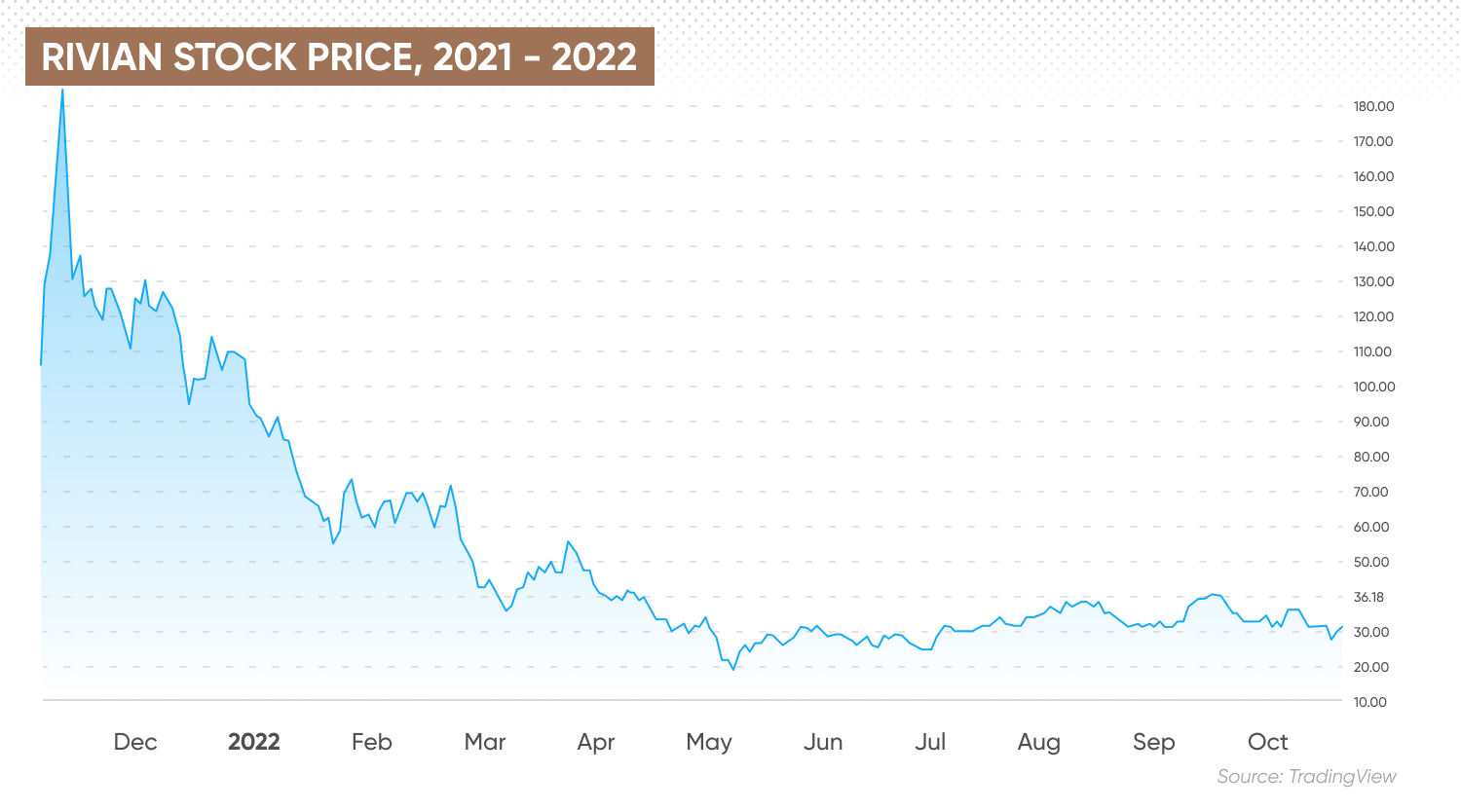Rivian stock forecast: Can fledgling EV maker recover?
What is the latest Rivian stock forecast as earnings season approaches?
Rivian (RIVN) has just delivered its third quarter production update. It had maintained output guidance with a 13.8% rise in share value only, only to lose this a few weeks later due to market recall. Most of its stock value has been lost through the first half of the year amid rising costs, while Ford’s suspected and then later confirmed sale of shares have also contributed to Rivian’s falling share price so far this year.
Can the share price begin to rise as vehicle deliveries start? Here we take a look at the latest Rivian stock forecast.
What is Rivian?
Rivian is an electric vehicle (EV) manufacturer specialising in heavy-duty EVs like pickup trucks. The company debuted on the Nasdaq in November 2021 through an initial public offering (IPO) valued at $78 a share.
In July this year, the EV maker planned to produce 25,000 models through 2022. Online retail giant Amazon (AMZN) has a 17.7% stake in the company - of which none have been sold to date. The company makes the R1T, starting at $69,500, and the R1S, starting at $72,500.
Rivian stock historical performance
Rivian might have debuted on the stock market at the worst possible time in the last 14 years. The EV maker floated on a buoyant Nasdaq through an IPO in November 2021. The RIVN stock price was initially valued at $79.
The stock opened above its IPO price at $100.71 followed by a spike to $170 within a week. At the time, equity markets were on a sustained bull run, and while Rivian contended with a downturn following its debut, it largely held its own through the remainder of 2021, closing the year at $103.69.

But a broad shock to the Nasdaq at the start of the year gave Rivian’s stock its first hammering, losing around half its value in January to close the month at $57.12. That month, Amazon purchased vans also from Stellantis in another blow to Rivian. However, Amazon later confirmed its continued support for Rivian, which improved investor sentiment again.
In addition, poor investor confidence in growth and tech stocks and rising inflationary pressures weighed heavily on the share price, while high material costs and downturns in demand, made companies like Rivian hands-off territory for many investors.
Further knocks followed in March with the announcement of the delay of deliveries of SUVs that month. By 29 March, the shareprice fell to $53.88. The price fell to $24.86 at the end of May with leaks of Ford considering selling 8 million of its 102 million shares and at the time Ford declined to comment.
There was a rise in the value to $36.16 in October with the delivery of the Third Quarter Production update maintaining output guidance resulting in a rise of 13.83%. However, on October 11, shares tumbled more than 7% to a new three-month low after a recall due to a defect related to a loose nut resulting in a loss of steering.
Since its debut, Rivian stock has lost three-quarters of its value, with uncertainty on where it will eventually settle.
Inflation and supply headaches
The major materials used in electric vehicle production skyrocketed this year, crashing burgeoning brands back down to earth and the reality of tight margins.
Lithium prices have risen rapidly in recent months, while nickel experienced a brief, dramatic rise before falling back to regular levels, while cobalt also experienced a similar spike at the start of this year, which was short-lived.
As a means of coping with these adverse headwinds, Rivian was forced to cut its production outlook in half in a letter to shareholders in March, from 50,000 to 25,000, sending shares down around 10%.
“As we continue to ramp up our manufacturing facility, manage supply chain challenges, face continued inflationary pressures and minimise price increases to customers in the near term, we expect to recognize negative gross margins throughout 2022," the company said at the time, amplifying the issues facing the company in the current environment.
According to the EV maker, production now remains in line with Rivian’s target of 25,000 a year, as indicated by the expectation-meeting 4,400 cars produced in the last quarter. A 1.8% uptick in sales, though, missed analyst expectations of 3.3-5.5% rise, as reported by CNBC.
In a bearish environment that looks unlikely to back risk for the foreseeable future, Rivian’s wait for profitability amid bumpy production issues looks unappealing in the short run.
Pricing issues
Supply issues have fed into pricing decisions across the sector, with several companies upping the entry point for their EVs, including Tesla (TSLA) rising prices in every month of 2021.
Rivan has made some costly errors as it negotiates this unfamiliar terrain. The EV maker’s stock still hasn’t recovered from a 20% plunge brought on by an embarrassing U-turn on pricing.
In addition to a narrowing of its product offering, Rivian increased the price of its R1T electric pickup trucks by about 17% and its R1S sport utility vehicles by about 20%. But the company neglected to exclude those who had already ordered from the increase, with evidence it instigated a wave of cancellations.
The scandal prompted a reversal and an apology from Rivian CEO RJ Scaringe, but it did little favour for the company’s bruised reputation and stock price, as reputational damage met with pessimism among investors that Rivian would successfully be able to pass on rising costs to its customers.
Rivian’s earnings show plenty of cash in the bank
Rivian posted earnings for the first quarter of 2022 (Q1 2022) on 11 May. At that point in the company’s evolution, investors were mainly watching for production volumes, available cash to sustain loss-making operations and how costs are impacting operations.
The company reaffirmed its target of 25,000 vehicles produced this year, with 90,000 pre-orders on its books.
Rivian reported $17bn in cash as of 31 March, with cash burn in the quarter of $1.03bn. The company made a net loss of $1.6bn in the quarter as production continued. It also began reporting revenues, raking in $95m in the quarter from its first deliveries.
A negative earnings per share (EPS) of -$1.43 beat analyst expectations of a $1.50 loss a share. The EV maker posted its Q2 2022 earnings on 11 August, with second quarter revenue above estimates, but expects a wider loss for the year.
In an analyst consensus compiled by MarketBeat, they expect the EV maker’s earnings to grow from -$7.37 per share to -$5.35 per share in the next year. In the previous quarter, Rivian Automotive missed the analysts’ consensus estimate of -$1.67 by 0.22 with a reported earnings per share (EPS) of -$1.89.
Rivian Automotive, Inc announced that at 5:00pm ET after market close on 9 November 2022, the company will release its third quarter 2022 financial results.
Where next for the Rivian share price? Analyst views
In a May note shared with Capital.com, Barclays analyst Brian A. Johnson was gloomy on Rivian’s short-term chances in the face of downgraded revenue outlooks amid production issues, cutting the stock’s price target by 37% to $24.
“1Q EPS marked a significant shift in Rivian’s product roadmap strategy, with the company narrowing its mid-term product offering to “optimise” capital efficiency and drive increased cash flow,” Johnson said in the note.
“While we appreciate the increased focus on cash (RIVN now expects cash on hand to fund the company through the R2 launch in Georgia in 2025), the trimmed-down product roadmap leads to our reduced revenue growth outlook; we reiterate our EW rating but cut our price target to $24 on the reduced revenue outlook.”
In another May note, Mizuho Securities’ RIVN stock forecast of $80 indicated investors were at a good entry point for the company.
“We believe RIVN could focus on R2 and its greenfield Georgia plant in order to reduce costs while driving its RT roadmap,” Vijay Rakesh, Managing Director at Mizuho, wrote in the note shared with Capital.com.
The analyst believes the EV maker will achieve $2bn per year, as opposed to $3.5bn expectations, by focussing on “efficient, streamlined R2 development”.
Rivian stock forecast
Based on the views of 21 analysts compiled by MarketBeat, as of 18 October, Rivian stock was a “moderate buy”, with 15 analysts marking the stock as a “buy”, seven in “hold” and two in “sell”. The RIVN stock forecast accordingly appeared tentative positive.
Analysts were split on the future on a Rivian stock forecast. Among analyst views compiled by CNN, Rivian had a median price target of $50.50, with a high of $83.00 and a low of $27.00. The median of Rivian stock predictions amounted to a potential upside of 60% on Rivian’s current price.
According to MarketBeat, Truist Financial delivered the most recent Rivian stock forecast for 2022, with an upgrade to $65.00. Royal Bank of Canada previously provided a more optimistic $75.00 target, but has amended the price target to $62.00.
Algorithm-based forecasting service Panda Forecast showed a Rivian stock forecast for 2025 of $42.62 by the end of the year.
Note that analysts and algorithm-based predictions can be wrong. Rivian share price forecasts shouldn’t be used as a substitute for your own research. Always conduct your own due diligence before trading, and never invest or trade money you cannot afford to lose.
FAQs
Is Rivian a good stock to buy?
Whether the stock is a suitable investment for you should be based on your personal circumstances such as risk tolerance, portfolio size and goals, and experience in the markets. Rivian (RIVN) could have high potential as it continues to ramp up production with the backing of Amazon. But it remains a high-risk growth stock with other competitors currently ahead of them. Always conduct your own due diligence before trading. And never invest or trade money you cannot afford to lose.
Will Rivian stock go up or down?
Based on analyst predictions compiled by CNN as of 18 October, Rivian (RIVN) has a potential upside for a median price target of $50.50. Note that analyst predictions can be wrong and shouldn’t be used as substitutes for your own research.
Should I invest in Rivian stock?
Whether you should invest in Rivian stock depends on your risk tolerance, portfolio size and investing goals, experience in the markets and other personal circumstances. Rivian investors should consider their confidence in Rivian to continue to produce at its target to fulfil a backlog of preorders, the EV maker’s appeal in the long run, and how the expansion of competitors like Ford and Tesla might affect Rivian’s final demand.
Always conduct your own due diligence before trading. And never invest or trade money you cannot afford to lose.